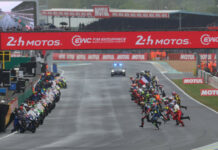Following problems occurring in the rear tyre of three riders during the Dutch TT at Assen last Saturday, Bridgestone immediately sent the affected tyres back to its Technical Centre in Kodaira, Japan, where they underwent intensive analysis to determine the cause of the irregularities. Bridgestone’s Manager of Motorsport Tyre Development, Shinji Aoki, was closely involved in the analysis of the rear tyres and here he explains what the contributing factors were at Assen that caused the problems in the rear tyres, and what measures Bridgestone will take to prevent such occurrences in future. Aoki-san, can you explain what were the causes of the problem that some riders experienced with their rear tyres at Assen? “There were three riders who had problems with the right shoulder of their rear tyre at Assen during the race, namely chunking of a piece of the tyre’s tread due to excessive heating of the rear tyre. Fortunately, none of the riders that experienced this issue crashed and the inner pressure of their tyres remained normal. “At Assen there were some factors that contributed to this potential increase in rear tyre temperature. Compared to last year, the ambient temperature was substantially higher, the capacity of the engines in MotoGP machines has increased from 800cc to 1000cc which brought with it an increase in torque and machine weight, while the layout of the circuit also changed which resulted in a marked improvement in lap times. “All these factors, in addition to the high camber of the Assen circuit, contributed to an increase in the potential for higher rear tyre temperatures and when combined with certain bike setups and riding styles, resulted in excessive heat build-up that caused tread chunking of some rider’s rear tyres. Though we were aware that this year’s Dutch TT would run under different circumstances due to the aforementioned changes in MotoGP machinery and weather conditions, we could not anticipate that these changes when combined with certain other variables such as particular riding styles and machine setup would result in such irregular rear tyre behaviour.” Were the affected rear tyres defective or have a manufacturing fault? “We performed detailed analysis of the affected MotoGP rear tyres from Assen, as well as other rear tyres from the same batch as the affected tyres and compared our results with analysis of a control set of tyres from another production batch. “All these tyres underwent extensive testing, including a simulation on a specialised test rig that uses a drum rotated at high speed to test the durability and operating behaviour of each tyre. This analysis definitively showed that there was no manufacturing fault with the tyres supplied at Assen.” Sachsenring is very hard on the left shoulder of the rear tyres; could a similar problem occur this weekend? “At Sachsenring it is usual for tyre temperatures to be higher than at other circuits, so for this event we traditionally have supplied special construction tyres that are specifically developed to handle extreme heat levels. So although relatively high tyre temperatures are expected this weekend during the German Grand Prix, the tyres supplied for this event are more than able to cope with this increase.” And what about at the Italian Grand Prix at Mugello which is the next race after Sachsenring? “Our analysis of the data acquired from Mugello shows that this circuit is not as severe on tyres as Assen, though as a precaution we will produce and deliver special construction rear slick tyres to next week’s Italian Grand Prix.” How will Bridgestone prevent this kind of problem occurring at future races? “Bridgestone will re-analyse its data from each circuit, including Assen, and use the lessons we have learned from last week’s Dutch TT to carefully consider the safety requirements and tyre severity ratings for each circuit and will then decide if any additional events on the calendar should also be supplied with special construction tyres.” For 2012, Bridgestone changed the construction of its rear tyres to make them less rigid. Was this a contributing factor to the significant increase in rear tyre temperature some riders experienced at Assen? “No, the difference in construction between last year’s tyres and the 2012 specification was not a contributing factor to the generation of extreme temperatures on the edge of the tyre and this was confirmed during evaluation of both specification tyres on the rolling drum test rig. The construction of the 2012 specification tyres does enable quicker warm-up performance, but this revised construction was not a factor in the excessive tyre heating that caused the problems experienced at Assen.”
Bridgestone Explains What Led To The Tire Problems Some MotoGP Riders Experienced At Assen
Bridgestone Explains What Led To The Tire Problems Some MotoGP Riders Experienced At Assen
© 2012, Roadracing World Publishing, Inc.





